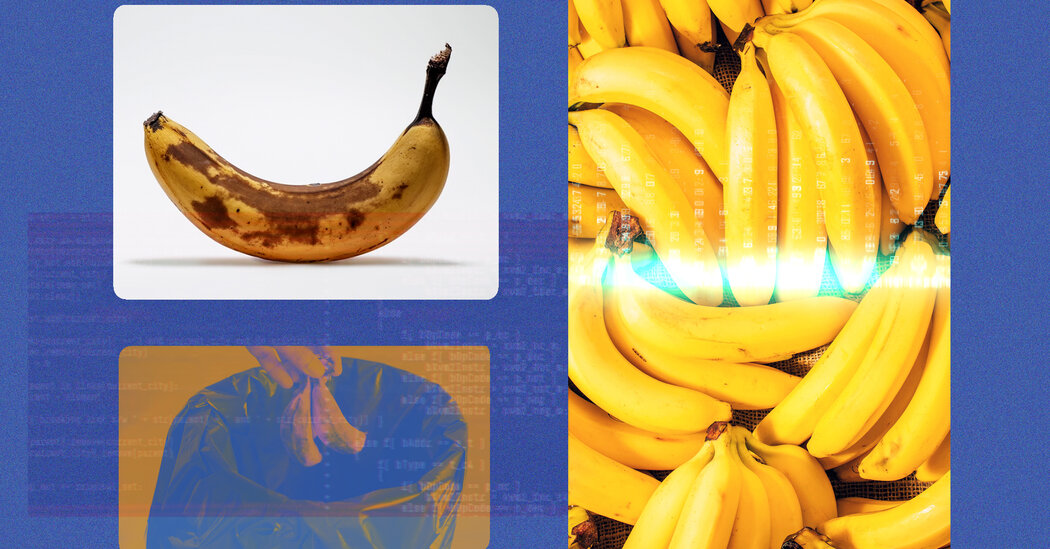A lodge chain installs a digital camera in its trash bins to spy on what company are tossing. Seems its breakfast croissants are too large. Many are going to waste — together with income.
A grocery store can instantly see, hidden in its personal gross sales information, that yellow onions aren’t promoting as quick as purple onions and usually tend to be trashed.
The brains behind each of those efforts: Synthetic intelligence.
It’s a part of an rising business that’s making an attempt to money in on a mindless human downside: The large quantities of uneaten meals that go from supermarkets and eating places to the dumpster. A lot of that, if it’s not composted, results in landfills the place it decays, sending potent planet-warming greenhouse gases into the ambiance.
Enter a brand new enterprise alternative. An organization referred to as Winnow has developed the A.I. instrument that spies on restaurant rubbish. One other, firm, Afresh, digests grocery store information to search for wasteful mismatches between what a retailer is stocking, and what individuals are shopping for.
A.I. has a grimy environmental footprint of its personal. Crunching enormous quantities of knowledge requires huge amounts of electricity. Nor can A.I. (but) alter what the human mind has come to count on in trendy, industrial societies: an abundance of recent avocados on the grocery store all 12 months, an ever-expanding number of tiny plastic yogurt cups, heaving platters of nachos on blissful hour menus.
Meals waste is a giant downside
The 2 corporations are a part of an rising business making an attempt to deal with an issue created by the fashionable meals business. In the US, a third of food that’s grown is never eaten.
Globally, 1 billion metric tons of food went to waste in 2022, in accordance with the United Nations Setting Program. Meals waste accounts for 8 to 10 percent of global greenhouse gas emissions, roughly equal to emissions from aviation and delivery mixed.
“It’s an issue that actually will get swept away,” stated Marc Zornes, the founding father of Winnow, which works with eating places, inns and institutional caterers.
Including to the issue: complicated “greatest by” and “promote by” labels on meals merchandise that lead to completely edible meals going into the trash.
Some supermarkets make a dent
Indicators of progress are rising from a bunch of grocery store chains that voluntarily pledged to cut back meals waste of their operations within the Western United States and Canada. Between 2019 and 2022, the eight chains which are part of the Pacific Coast Meals Waste Dedication undertaking reported a 25 percent decline in their total volumes of unsold food.
Additionally they reported donating extra meals to charities and sending extra of their waste to compost services, that are scarce, as an alternative of landfills.
“It demonstrates that the nationwide aim to chop meals waste in half by 2030 could, the truth is, be attainable, however we would want dramatically extra motion throughout all food-system sectors for that to occur.” stated Dana Gunders, head of Refed, a analysis and advocacy group that tracks the voluntary undertaking’s information.
There are lots of new instruments now to assist retailers minimize waste. Some startups, like Apeel and Mori, provide coatings for recent produce in order that they don’t spoil as quick. An app referred to as Flash Meals connects prospects to discounted meals at grocery shops, much like Too Good to Go, which connects prospects to eating places and grocers promoting extra meals at low cost.
What number of eggs this week?
Afresh’s expertise grinds round six years of gross sales information on each product within the fresh-foods part of a grocery retailer it really works with. Its A.I. instrument can divine when folks purchase avocados, and at what value. It might probably mash that up with information on how rapidly avocados spoil and in flip advise what number of avocados to inventory.
If Easter egg portray season historically brings extra egg gross sales, it may possibly calculate what number of extra circumstances of eggs the shop ought to order, and likewise, what number of extra bell peppers as a result of buyers normally make omelets with the additional eggs at dwelling.
Whereas an skilled retailer supervisor would doubtless know this, stated Matt Schwartz, co-founder of Afresh, the A.I. would provide extra exact details about many extra merchandise. It might suggest, as an illustration, that the shop supervisor order 105 circumstances of eggs the week earlier than Easter, reasonably than 110. “Each one case issues,” he stated.
Additionally, stated Suzanne Lengthy, the sustainability chief for Albertson’s, which makes use of Afresh expertise, skilled retailer managers are more and more uncommon. “What the A.I. is doing is giving us the preciseness. Not simply ‘I have to order onion’ however ‘any such onion,’” she stated.
Ms. Lengthy stated the chain has diminished meals waste however declined to say by how a lot.
This robotic doesn’t dumpster dive
Winnow installs cameras above rubbish bins in restaurant kitchens. The pictures are fed into an algorithm that may inform the distinction between a half pan of lasagna (beneficial) and a banana peel (not a lot). A gaggle of Hilton Inns that rolled out the instrument lately discovered lots of its breakfast pastries had been too large — and likewise that baked beans had been generally left unfinished.
Refed, the analysis group, present in its 2022 estimates that 70 % of wasted meals at eating places is meals that’s left on the plate, signaling a have to rethink portion sizes.
Mr. Zornes works primarily with inns and cafeterias. He estimates eating places waste between 5 and 15 % of the meals they purchase. “That is an apparent downside everybody is aware of about,” Mr. Zornes stated. “It’s clearly an issue we’re not fixing.”
Source link









